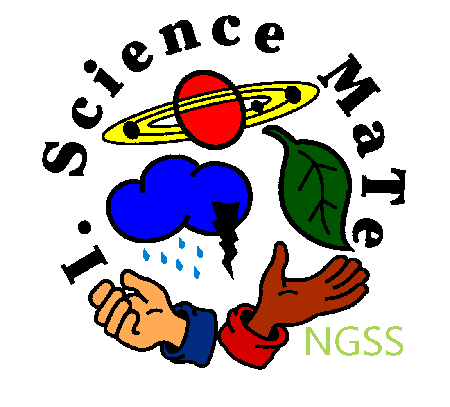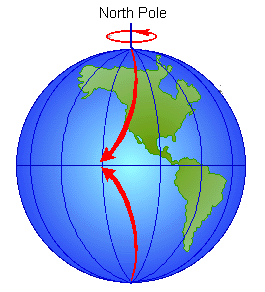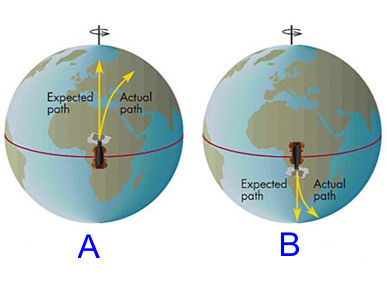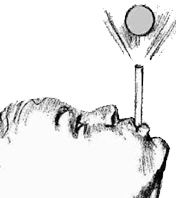|

|

Sixth Grade Integrated NGSS
Weather, Climate and Change
|
|
Effect of Rotation of Earth on Oceans and Atmosphere |
SIXTH GRADE - CORIOLIS MoTION
OBJECTIVES:
·
Exploring the movement of oceans and atmosphere.
·
Discovering Coriolis motion.
VOCABULARY:
·
Coriolis Motion
·
ocean
·
atmosphere
·
rotation
MATERIALS:
·
worksheet
·
small wax cup
·
circle cut from construction paper
·
Small nail
·
Water bottle with dropper
·
Ping pong ball
·
Straw
·
Powerpoint “Oceans and Atmosphere”
VIDEOS
1. The Coriolis effect (MIT
demonstration)
https://www.youtube.com/watch?v=dt_XJp77-mk
2.
Coriolis effect (Coriolis effect on weather)
https://www.youtube.com/watch?v=i2mec3vgeaI
|
BACKGROUND:
The rotation of the Earth on its axis causes what is called the Coriolis Motion.
(The name comes from a
19th-century French engineer-mathematician Gustave-Gaspard Coriolis in
1835.)
The Coriolis Motion is a major overlay
on the pattern, and this has to do with deflection of particles because of this
motion. The earth's rotation affects the oceans and the atmosphere.
The classic example that you can perform with your children is to have
them throw a ball to a person when they are on merry-go-round. The ball
will be thrown straight, but will appear to be deflected to the people on the
merry-go round. This is an analog to the movement of water in our oceans.
In the northern hemisphere this deflection is to the right and in the southern
hemisphere this deflection is to the left.
The rotation
of the Earth affects the outer portions of the Earth. The effect on the
oceans is a steady and continuous reaction, which causes the general direction
of the ocean's motion. This is called the Coriolis Motion causes the
Coriolis Effect, whereby water is deflected to the right in the Northern
Hemisphere and deflected to the left in the Southern Hemisphere. Many times the
words are used interchangeably. The Coriolis
Motion is a difficult phenomenon to fully understand, but it is important for
children to realize the influence of a rotating sphere on the motion in the
ocean and ocean currents.
If you would like to see this motion, look at the following UTube from MIT.
https://www.youtube.com/watch?v=dt_XJp77-mk
The atmosphere also moves because of this rotation as seen in wind patterns.
There is a difference between local and general worldwide winds. General winds
include those that stretch thousands of miles over the Earth's surface with
almost permanent directional patterns. Local winds are characteristic of
particular geographical regions and exert a pronounced influence on the local
climate.
The pattern of the general wind circulation is primarily determined by the
unequal heating of the atmosphere at different latitudes and altitudes and by
the effects of the Earth's rotation. The general wind pattern includes doldrums,
jet stream, polar easterlies, trade winds, and westerly winds.
There are also other reasons that you have to consider for motion of the oceans
and atmosphere. If you would like
more information please go to the following link :
https://msnucleus.org/membership/html/jh/earth/index.html
click on the
units under Water Science
These
readers can help you understand the material better.
It is complicated, but these units help the children begin to understand
this motion.
PROCEDURE:
1.
Movement on
Earth is very difficult to understand, especially when children think that when
they stop, there is no movement. Wrong! Ask the children to think of
themselves as Martians, looking at the Earth through their spaceship. If you
have an inflatable or solid globe, show it rotating on its axis.
As the Martians look at this blue planet called Earth, they
notice that polar bears and penguins look like they are standing still (acting
cool), but people especially those that live near the equator are moving around
very quickly, about 1000 miles per hour! But do the people feel like they
are moving that fast? Of course not, but the Earth is moving along its
axis, a particle near the axis moves slower than a particle along the equator,
which has a longer distance to travel. Hence, the Martian
would see polar bears (who live only near the north pole) and penguins who
live only near the south pole) as moving very slowly.
This
movement causes motion on the crust of the Earth, but because the ocean is a
liquid and the atmosphere is a gas, they responds quicker than the solid Earth
and one of the main reasons we have ocean and wind currents.
2.
Use the
powerpoint presentation on “Oceans
and Atmosphere” and go over the main points of rotation and solar radiation that
drives the surface ocean and atmospheric movements.
3.
First
activity is to prove that motion can cause a deflection and it is different if
you are moving clockwise or counterclockwise.
EXERCISE I.
ocean movement on a
spinning planet
1. Hand out small earth balls and worksheet.
Have them follow the instructions to figure out which was the earth
appears to move (to right or left) from the perspective of the north or south
pole and fill in worksheet.
2.
Use the powerpoint presentation on “Oceans and
Atmosphere” and go over the main points of rotation and solar radiation that
drives the surface ocean and atmospheric movements (slides 1-6).
3. Play the two videos.
The first shows the effect by throwing a ball.
The second goes over the principal on a global scale and how it affects
weather.
Ask the students to make a
prediction as to what direction they think the ocean currents will move in the
northern and southern
hemisphere
1.
Place small wax cup down.
2.
Place a piece of heavy construction paper on small
end.
3.
Firmly place nail or pin through center of
construction paper (being careful not to allow nail head to come through).
4.
Push nail through the bottom of the cup so paper
can spin on the tail on top of the cup.
Turn nail upside down (head facing table) and spin like a top with the
construction paper spinning on top of cup.
5.
Fill medicine dropper with water
6. One partner should spin the
construction paper right to left. As the construction paper is spinning, the second
partner will drop 1-3 drops of water as close to the nail as
possible. They will see curved tracks
from the center. They should enter
what this looks like on their worksheet.
Ask the students to make a predition as to what direction they think the ocean
currents will move in the northern and southern hemishphere.
1.
Place small wax cup down.
2.
Place a piece of heavy construction paper on small end.
3.
Firmly place nail or pin through center of construction paper (being careful not
to allow nail head to come through).
4.
Turn nail upside down (head facing table) and spin like a top with the
construction paper spinning on top of cup.
5.
Fill medicine dropper with water
6.
As the construction paper is spinning, the second partner will drop 1-3 drops of
water as close to the nail as possible.
Have the students change the direction of the spin and record what happens.
This demonstrates that a moving "sphere" deflects particles because of the
motion. This is the same thing on the Earth, except the water can't just
"fly" off.
(Because of other forces like
Centripetal Force.).
Below a projectile that is thrown toward north (and person is facing
north) it deflects to the right. In B the projectile is thrown to
the south and person is facing south, it deflects to the left.
 |
 |
| Deflection of a
particles in northern (A) and southern (B) hemisphere |
Keeping a ping-pong ball suspensed |
EXERCISE
II.
The power of air movement--wind currents
1. Give 2 students small paper cup, a bendy straw and medium puff ball.
Cut the end of the bendy part off so it is just above the bend.
Make a small hole in the middle of the bottom of the cup so that the
straw will fit snuggly. (See
photos). Blow in the straw and the
puff ball will float and spin above the bottom of the cup.
Have students see how well they can keep the puff ball in the air without
it going out of the cup.
The puff ball should seem like it is floating, but
gravity is pushing it down and the air is pushing it upwards.
This activity shows that wind
currents can be strong enough to life things. (This is referred to as
Bernoulli’s Principle.)
2
Next,
have students play “soccer ping pong.”
Put the ping pong ball in the center between them and have them try to
blow it in the others side. Put
obstacles between them and have them direct the power of the wind.
Discuss with them that wind cannot go through things, so you have to blow
at the right angle to move the ball.
This is similar to what happens on Earth.
Air goes up mountains, around houses, and down steep slopes causing the
wind to go slower or faster.
There are many reasons for this, but the
activity is just trying to get children to see that
wind is a force.
3. Make a small tent with heavy
paper see if they can get the ping pong ball to go up the sides; ask students to
find different ways to move the ball and share their discoveries at the end. Can
they get the wind to go over the “mountains”?
4. If here is time you can let them
try to move the ping pong ball using straws to blow with.
They will get more power on the ping pong ball since the wind is more
controlled. This gives the idea of
different wind strengths.
Return
to NGSS Model



